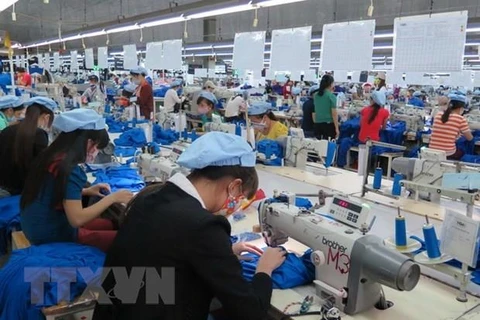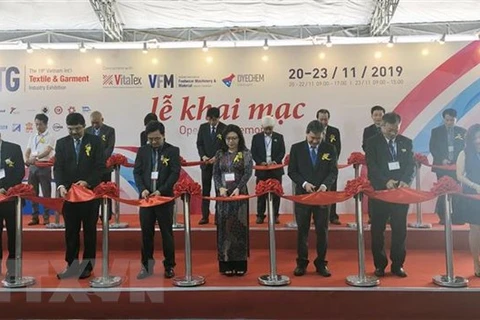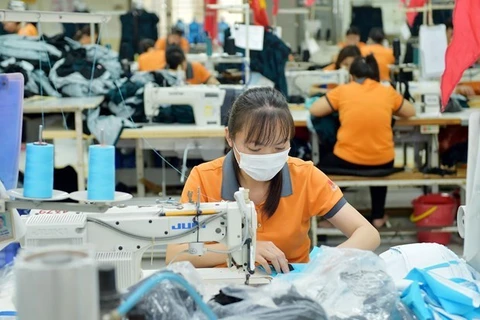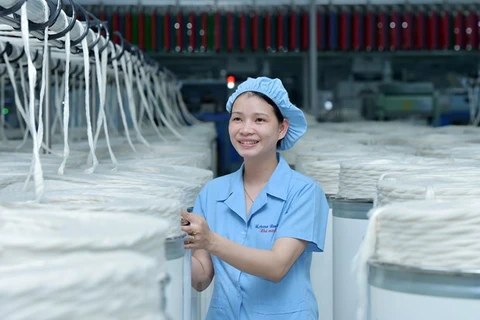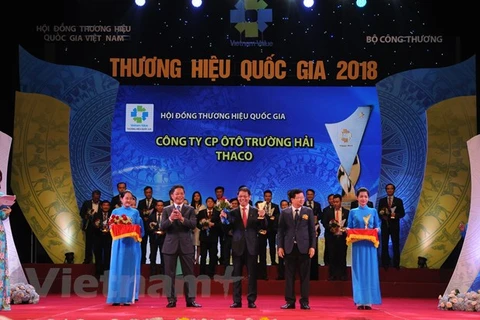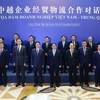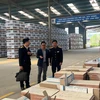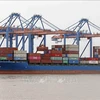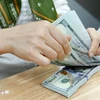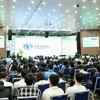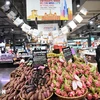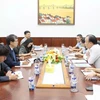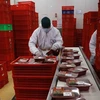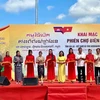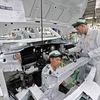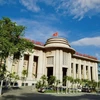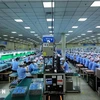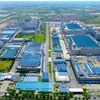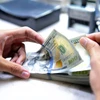 Minister of Industry and Trade Tran Tuan Anh works with garment-textile and footwear firms in Hanoi to remove difficulties for business and production (Photo: Xuan Quang/VietnamPlus)
Minister of Industry and Trade Tran Tuan Anh works with garment-textile and footwear firms in Hanoi to remove difficulties for business and production (Photo: Xuan Quang/VietnamPlus)
Hanoi (VNA) - One of the biggest weaknesses of many domestic manufacturing industries is the heavy dependence on foreign supply chains, according to the Department of Industry under the Ministry of Industry and Trade.
This fact also entails the import of raw materials from many countries such as China and the Republic of Korea, resulting in low added value of domestic industries.
Therefore, the development of supporting industries is important for economic restructuring, improving productivity and labour skills, as well as increasing added value, competitiveness and quality of products.
This is also one of the most important solutions for Vietnam to grow sustainably in the long term and improve the quality of its economy, according to insiders.
Flexible moves
Data released by the Ministry of Industry and Trade showed that in 2019 alone, Vietnam spent 2.47 billion USD importing cotton of all kinds and 2.3 billion USD buying fiber and yarn, and up to 12.69 billion USD purchasing fabric and 5.61 billion USD importing garment-textile and footwear materials, mainly from China and the Republic of Korea.
The dependence on foreign suppliers has limited the competitiveness of businesses, especially during the COVID-19 pandemic.
Pham Xuan Hong, chairman of Ho Chi Minh City Textile and Apparel Association (AGITEX), said about 50 percent of apparel materials are imported from China.
Among the countries that Vietnam could buy materials, only the Republic of Korea has a free trade agreement with the European Union (EU). However, the Northeast Asian country does not have sufficient materials to supply for Vietnam’s garment-textile industry.
Garment-textile is a specific industry linked by a supply chain from raw materials to spinning, weaving, dyeing, and sewing on a global scale
In Vietnam, in addition to large foreign direct investment (FDI) enterprises that own the whole supply chain, only few domestic ones have the stage of dyeing but with small scale and average quality.
Meanwhile, most of the local small dyeing businesses exist in craft villages with outdated technology. Therefore, the reliance on imported raw materials makes it difficult for Vietnam to escape from processing in the sewing segment, which has very low production value, according to Hong.
Rolling out red carpet to welcome investors
In order to remove bottlenecks in the garment-textile industry, economists suggested devising more policies to develop supporting industries and mapping out a national plan on building material zones and strategies to develop material areas or alternative imported material sources.
With many years of experience in this field, Vu Duc Giang, Chairman of Vietnam Textile and Apparel Association (VITAS), said the apparel industry needs to remove bottlenecks in the supply chain.
He recommended the State developing plans to develop the garment-textile industry for 2035-2040.
The Ministry of Industry and Trade should be a pillar in the strategy of building a supporting platform for the sector as well as a legal foundation to attract investment, he said.
He cited that in 2019, garment-textile exports brought home nearly 40 billion USD. Vietnam’s apparel products were sold to the most choosy markets such as the US, EU, Japan and the Republic of Korea.
He added that the biggest bottleneck of the footwear and apparel industry is only joining the value chain in the low-end segment, mainly processing, while the stage of branding and designing to create high added values is still limited.
Besides, domestic enterprises still have to import a large amount of materials to serve production and exports. Therefore, to create breakthrough policies, Hoai said the ministry will focus on resolving all the aforesaid matters and develop raw material supplies.
Particularly, to make effective use of the freshly signed Comprehensive and Progressive Agreement for Trans-Pacific Partnership (CPTPP) and the EU-Vietnam Free Trade Agreement (EVFTA), Hoai suggested businesses investing in building modern production lines.
The ministry is drafting a resolution revising and supplementing some contents of the Government’s Resolution 111/2015/ND-CP on developing supporting industries with many incentives to promote investment in this field, he said.
 Trade fairs create an opportunity for garment-textile firms to seek potential partners and update cutting-edge technologies. (Photo: Xuan Quang/VietnamPlus).
Trade fairs create an opportunity for garment-textile firms to seek potential partners and update cutting-edge technologies. (Photo: Xuan Quang/VietnamPlus). To maintain the position of Vietnam's textile and garment industry in the world, experts advised enterprises to take new measures to change production and business methods to create opportunities for expanding markets.
Besides, businesses should cooperate with customers to form a production chain, meeting the rules of origin as committed in free trade agreements (FTAs)./.

